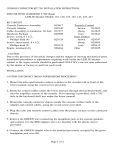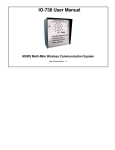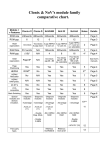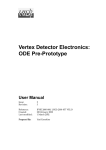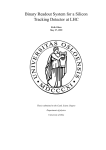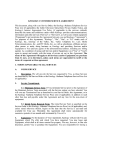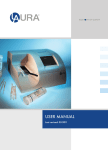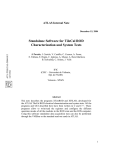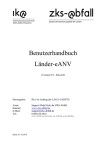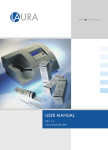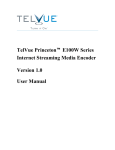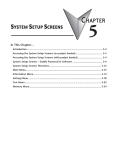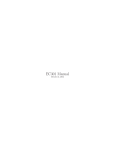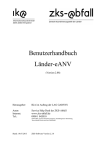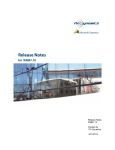Download MuSTARD User Manual
Transcript
MuSTARD 1. Overview MuSTARD (Multichannel Semiconductor Tracker ABC(D) Readout Device) is designed to receive, store and decode the data from multiple Atlas SCT ABC(D) modules in either the TSP (testbeam setup) or the System Test at CERN. It may also find use in multiple-module production-test systems. There are 12 input streams. Each stream is synchronised to the system clock and buffered in a FIFO. The readout control circuit event-builds the stream data and outputs complete events to the host via a multipage dual-port memory. It also provides the capability of histogramming hit channels on the fly without incurring a time penalty. MuSTARD is an electrical module, ie its data inputs are electrical, differential LVDS. Fig 1 shows the role of MuSTARD in a readout system and fig 2 shows the main features of MuSTARD. 1.1 Format MuSTARD is a 6U single width VME module. It is an A32 module, but may be operated for test purpose as an A24 module, this mode being selected by means of a jumper. All transfers are D16, programmed. Block transfer is not supported. An address space of 1 Mbyte is occupied, with a 12-bit base address selectable by 3 hex switches. (In the A24 test mode only the least significant switch is functional) MuSTARD responds to AM codes 9,A,D and E in A32 mode and 39,3A,3D and 3E in A24 mode. DTACK is asserted for any 16-bit transfer within the 1 Mbyte address space. BERR is never asserted. 1.2 power requirements MuSTARD requires +5V and -5.2V. The -5.2V may be provided via the JAUX connector if used in a CERN standard crate or via the J2 connector if used in a normal VME crate. In this case the user has to provide -5.2V and 0Vat the appropriate J2 pins. The pins used are compatible with the VXI standard and are the same as on the SEQSI. However, because MuSTARD requires J2 to be present, the ground and -5.2V connections to J2 are made via jumpers, allowing these pins to be isolated if required. 1.3 Front Panel Connectors A 26-pin header connects the 12 LVDS inputs. A 10-pin header connects clock and command signals from the Clock/Trigger system and carries a BUSY signal from MuSTARD to the Clock/Trigger system. Test sockets are provided to allow the synchronised signals (multiplexed) to be scoped. 1.4 Front Panel LEDs LEDs indicate some of the module states, eg Fifo Full. MuSTARD.doc 17/09/98 page 1 of 15 MuSTARD.doc 17/09/98 page 2 of 15 Junction Cable or "dog-leg" pigtail low-mass A opto board M O D U LE b a fi le) fig 1 low-mass B clo 1 p ck, co er m mo man dul d f ibre e s da t r es er (2 p du mo BILED Host conventional clock, ctrl Oxford FOD module opto receiver busy high volts low volts ? ? Host clock, trigger system clock,ctrl MuSTARD Host 2. MuSTARD.doc 17/09/98 page 3 of 15 stream 0 stream 1 stream 2 stream 11 + _ _ + + _ + _ prog delay prog delay prog delay prog delay control logic control logic control logic control logic fig 2 9 9 9 9 FIFO FIFO FIFO FIFO histogram memory stream readout logic, decoder event output buffer I/F VME VMEBUS VME Functions and Address Map Fig 3 shows the VME address map. There are 3 areas, the CSR registers, the Event Output Buffer and the Histogram Memory. All addresses are relative to the base address. 2.1 CSR Registers All transfers to these registers are 16-bit, aligned to even byte boundaries. 2.1.1 Register 0, Module Reset Base Address. Write only. Module Reset. The module is reset by writing 1 to d0, then writing 0 to d0 to release the reset. d0 All other bits ignored. 2.1.2 Register 1, Readout Control Base Address + 2. Read and write. MRDOEN when 0, transfer from the fifos to either the output buffer or the histogram memory is d0 inhibited and VME access to the histogram memory is enabled. When 1, transfer from the fifos is enabled, and VME access to the histogram is prevented. VME access to an output buffer page is enabled, but only when an event is available to be read. MDAQEN When 0, writing to the fifos is inhibited. d1 d2:15 are ignored when writing. d2,3,5,6 and 7 are zero when read, d4 indicates the state of the I2C bus, see later. d8:15 are undefined. MDAQEN and MRDOEN are cleared when Module Reset is asserted. 2.1.3 Register 2, Readout Mode Base Address + 4. Read and write. Sample_All. If sample_all is true, then readout from the fifos takes place only if one of the 4 pages of the d0 output buffer is available. If it is false then readout from the fifos takes place as fast as possible, with the hit channels being histogrammed and events going to the output buffer as pages become available. Raw_Mode. In this mode (d1 = 1) the data is written to the output buffer without being decoded. The data d1 is written to the output buffer as 16-bit words with d(15:13) being zero, d(12:9) indicate the stream number, d(8) is a marker bit indicating end of a stream event, and d(7:0) is the stream data. In Decoded Mode (d0 = 0) the data is decoded acording to the ABC(D) protocol and then written to the output buffer. The decoded data format is shown later, in the section on the output buffer. d2:15 are ignored when writing. d2,3,5,6 and 7 are zero when read, d4 indicates the state of the I2C bus, see later. d8:15 are undefined. 2.1.4 Register 3, Clock Control Base Address + 6. Read and Write d 0 USEXCK Allows the internal 40 MHz oscillator to be used for test purposes. d1:15 are ignored when writing. D1:3,5:7 are zero when read, d4 indicates the state of the I2C bus, see later. d8:15 are undefined. 2.1.5 Register 4, Test Mode Base Address + 8. Read and Write d(1:0) selects the test operating mode. d2:15 are ignored when writing. d2,3,5,6 and 7 are zero when read, d4 indicates the state of the I2C bus, see later. d8:15 are undefined. MuSTARD.doc 17/09/98 page 4 of 15 2.1.6 Register 5, Status Register Base Address + A. Read only. The significance of the bits will be explained in more detail later. d 0:3 SADD 0:3 The stream address. Generated by the stream readout logic. d4 MDAQEN Enables data to be written to the fifos. d5 MRDOEN Enables data to be read from the fifos. d6 RD_PAGE 0 The output buffer has 4 pages, RD_PAGE 0,1 select a page for reading. d7 SSTAT Indicates to the stream readout logic if the stream being addressed is enabled. d8 SDAV Indicates to the stream logic if the stream being addressed contains data. d9 SREN Stream Read Enable. The signal issued by the stream readout logic to read data from the fifos. d 10 TRH* Trigger Hold. This signal is asserted (active low) when an enabled streams fifo almost full, or when an enabled stream’s trigger count exceeds the programmed limit. d 11 BCO_OK Indicates that there has been no interruption of the beam crossing clock detected since the last Module Reset d 12 RD_PAGE 1 d 13,14 WRITE_PAGE 0,1 2-bit address of the next page of the output buffer available for writing. d 15 Always 1. 2.1.7 Register 7, Test Fifo Base Address + C. Write only. d 13:0 sends data to the TEST FIFO. The test fifo allows programmed test data to be sent to the stream storage fifos, thus permitting all the main MuSTARD functions to be tested. d 14,15 ignored. 2.1.8 Register 8, Test Trigger Base Address + 10. Write only Data ignored, initiates the transfer of test data from the test fifo to the stream storage fifos. MuSTARD.doc 17/09/98 page 5 of 15 control and status 0 control and status 8000 event output buffer m em ory 0 2 4 6 8 A E 10 10000 histogram m em ory 80 A6 m odule reset readout control register readout m ode register clock control register test m ode register status register test fifo generate test trigger delay chips 100 stream logic 'm us-bus' 1FFFF 17E stream logic delay chips 80 82 84 86 90 stream 0 stream 1 stream 2 stream 3 stream 4 stream 5 stream 6 stream 7 100 104 108 10C 110 stream 0 m ode register stream 0 trig lim it stream 0 PAF reg stream 0 status reg stream 1 120 stream 2 130 stream 3 s tre am s 4:9 A0 stream 8 stream 9 stream A stream B 1A0 1B0 MuSTARD.doc 17/09/98 stream A stream B page 6 of 15 2.2 Delay Chips There are 3 4-channel delay chips per MuSTARD. Each channel delays the input data by 0-24 nS, selectable in steps of one nS ie 5 bits, d(4:0). These chips are written to by transfers to base_address + 80 + 0,2,4,6 for streams 0-3, base_address + 90 + 0,2,4,6 for streams 4-7 and base address + A + 0,2,4,6 for streams 8-11. These transfers are normal VME writes. Data is transferred automatically to the chips by the I2C serial protocol, and each transfer takes approximately 200 μS. This area (80- A7 inc) is write only, but reading any of registers 1,2 or 3 gives the status of the transfer, d4 = 1 means transfer is taking place. A new transfer should not be initiated until the previous one has concluded. Only data in the range 0-24 inc. should be written to the delay chips. 2.3 Stream Logic There are 2 registers associated with each stream and 2 registers associated with each group of 4 streams. 2.3.1 Stream Mode register Base address + 100 + Stream Number * 10. Read and write. One register per stream. When writing, Stream Enable d0 d 1:15 ignored. When reading, d0 Stream n Enabled d1 Stream n + 1 Enabled d2 Stream n + 2 Enabled d3 Stream n + 3 Enabled where n is 0 for stream numbers 0 to 3, 4 for stream numbers 4 to 7 and 8 for stream numbers 8 to 11. d 4 is zero d 5:15 undefined. 2.3.2 Stream Status Register Base address + 10C + Stream Number * 10. Read only. One register per stream. d 0 Fifo Empty Flag. When d0 is 1 then the fifo contains no data. d 1 Almost Full flag. When d1 is 1 then the fifo is Almost Full. d 2 Trigger Overflow. When d2 is 1 it indicates that the stream’s trigger counter - which counts up for received L1 triggers and counts down for events received from detector data streams - contains a number greater than the programmed limit for that stream. d 3 Fifo Full Error Flag , when d4 is 1 it indicates that the FULL FLAG of the fifo has been asserted at least once since MDAQEN was last asserted. When a fifo’s FULL FLAG is asserted it is likely that data will have been lost. All Fifo Full Flag Error Flags are cleared when MDAQEN is deasserted. d 4 Trigger Count Error Flag. This signal is set when the Trigger counter indicates that the number of L1 triggers received exceeds the number of events received by more than 30, or that the number of events received exceeds the number of L1 triggers received. All Trigger Count Error Flags are cleared when MDAQEN is deasserted or when a RESET COMMAND is detected. d 5:15 are undefined 2.3.3 Trigger Limit Register Base address + 104 + Stream Number * 10. Read and write. One register per 4 streams. One register corresponds with streams 0-3, the second register corresponds with streams 4-7, the 3rd register corresponds with streams 8-11. d 0,1 TLR 0,1. These 2 bits determine the value of trigger count at which Trigger Overflow is set. When TLR 1:0 = 0, trigger overflow occurs when the trigger count is greater than 3 When TLR 1:0 = 1, trigger overflow occurs when the trigger count is greater than 7 When TLR 1:0 = 2, trigger overflow occurs when the trigger count is greater than 15 When TLR 1:0 = 3, trigger overflow does not occur. d 15:2 are ignored when writing. When reading, MuSTARD.doc 17/09/98 page 7 of 15 d 2:4 are zero, d 3:15 are undefined. 2.3.4 PAF Register Base address + 108 + Stream Number * 10. Read and write. One register per 4 streams. One register corresponds with streams 0-3, the second register corresponds with streams 4-7, the 3rd register corresponds with streams 8-11. Each fifo has a Programmable Almost Full flag. Writing to the PAF register causes the register value to be written to the fifos as an offset from full at which the PAF will be asserted. d 0,1 PF0,1. The offset from full is the value of PF 1:0 * 2K + 2K. 2.4 Output Buffer The output buffer is a 4-page dual-port ram, each page being 16K*16, with the pages being controlled by a fifolike circuit. MuSTARD writes one complete event to one page. The buffer is full when it contains 4 unread events. To the host, the memory looks like a single 16Kword page, starting at Base Address + 8000. Only complete events are made available. The host must determine the availability of an event by reading the first word of the memory. A negative value (ie bit 15 set) indicates that there is no data available. In fact when the first memory location is read and no event is available it is the data from Status Register which is actually read. The availability of an event is signalled by the value of the first word being positive, ie with bit 15 = 0. The number of words in the event are indicated in bits 13:0. If bit 14 is set it indicates that an error (either an error code from the front-end chips or a protocol violation) was detected at some point in the event. Error detection and counting only occurs when running with Decoded Mode. When the host has finished with an event it must signal this to MuSTARD by writing to the first memory word (data ignored). When running in DECODED Mode (RAW_MODE = 0) the data format is as shown in fig 4. When running in RAW Mode the data is transferred directly from the stream fifos with no alteration. In this case the format is: d8:0 is raw fifo data, with d8 indicating the end of a stream’s event. d 12:9 indicate the stream number. MuSTARD.doc 17/09/98 page 8 of 15 d15 d14 d13 d12 d11 d10 d9 word count error count E d8 d7 d6 d5 d4 d3 d2 d1 d0 w13 w12 w11 w10 w9 w8 w7 w6 w5 w4 w3 w2 w1 w0 er15 er14 er13 er12 er11 er10 er9 er8 er7 er6 er5 er4 er3 er2 er1 er0 event count ec15 ec14 ec13 ec12 ec11 ec10 ec9 ec8 ec7 ec6 ec5 ec4 ec3 ec2 ec1 ec0 event count ec31 ec30 ec29 ec28 ec27 ec26 ec25 ec24 ec23 ec22 ec21 ec20 ec19 ec18 ec17 ec16 stream event header 1 0 0 stream number 0 0 strip address t3 t2 t1 t0 b7 b6 b5 b4 b3 b2 b1 b0 s3 s2 s1 s0 0 1 0 0 a2 a1 a0 data 0 0 1 d2 d1 d0 data 0 0 1 d2 d1 d0 c3 c2 c1 c0 a6 a5 a4 a3 1st stream event stream event header stream number strip address 1 b2 b1 b0 s2 s1 s0 a3 a2 a1 a0 1 d2 d1 d0 1 d2 d1 d0 0 0 0 0 0 1 0 0 0 0 0 data data b3 s3 0 t3 t2 c3 t1 c2 t0 c1 b7 c0 b6 a6 b5 a5 b4 a4 next stream event fig 4 2.5 Histogram Memory This is a 32 Kword (64 Kbyte) memory, starting at Base Address + 0x10000 Read and write. Each stream is assigned a 2 Kword segment. Within the segment, hit strips are mapped according to the 7 bit strip number and the 4 bit chip number. Normally only 768 locations of a 2 K segment will be active, but if the redundancy scheme whereby the data of 2 sides of a module can be routed to a single fibre is used then 2 groups of 768 words will be active. The histogram memory can be accessed from VME only when MRDOEN is not asserted. There is no “clear” command for the histogram memory, it must be cleared by writing zeroes to it. MuSTARD.doc 17/09/98 page 9 of 15 14 13 S3 S2 12 11 S1 S0 C3 S tre a m N u m be r MuSTARD.doc 17/09/98 10 9 8 7 6 C 2 C1 C 0 a6 C h ip N um b er 5 4 3 2 1 0 a5 a4 a3 a2 a1 a0 S tr ip N um ber page 10 of 15 3. Operating Guide 3.1 Clock A “Beam Crossing” clock (40 MHz) is input to MuSTARD at differential ECL levels on pins 7 and 8 of the frontpanel mounted 10-pin IDC plug. This clock is used as the system clock. A 40 MHz crystal oscillator is used as the frequency reference for the delay chips, and may also be used for test purposes to replace the BC clock for all functions. This is implemented by writing to the Clock Control Register. The VME Interface circuit itself requires a clock. This is normally the BC clock. However to avoid the VME Interface hanging up if the BC clock (an external signal) was lost MuSTARD includes a circuit which continuously compares the frequency of the BC clock to that of the internal 40 MHz crystal clock and if they are not approximately the same the VME interface is switched to the crystal clock until the BC clock is restored. This feature only allows the VME Interface to continue functioning but most of the other circuits will be nonfunctioning. A jumper (pl )allows the frequency checking feature to be disabled. 3.2 Control Data This is the signal used to send L1 triggers and other commands to detector modules. It is input to MuSTARD as differential ECL on pins 9 and 10 of the 10-pin plug. As a Data Receiver MuSTARD does not make direct use of this signal in its data acquisition, but it can be used to keep track of the number of unread events in the front-end buffers. The data is decoded to extract the L1 triggers and the Soft Reset. All other commands are ignored. Control Data 9 10 + _ Trig Control Data Decoder reset 470 0hm front panel lemo skts 470 0hm 3.3 Busy Busy is a differential ECL signal which is output by MuSTARD as differential ECL on pins 1 and 2 of the 10-pin plug. It is asserted if any enabled stream’s fifo has sufficient data that its Almost Full Flag is asserted, or if any enabled stream’s “trigger count” exceeds the programmed limit. The trigger count is a counter, one for each stream, which is incremented when an L1 trigger is detected on the Control Data input and decremented when a trailer (ie end of event) is detected on a stream. The busy signal may be used to inhibit further triggers until it is de-asserted. The contribution of the trigger counters to Busy can be turned off ( by writing 3 to the Trigger Limit Registers associated with enabled channels) but the contribution by the Almost Full Flags can not, other than by disabling a stream. 3.4 Stream Inputs There are 12 input streams at LVDS levels on pins 1 to 24 of the 26 pin front panel mounted IDC plug. Pins 25 and 26 of this plug may be connected to ground by means of a jumper, PL3, or they may be left open. The inputs are latched by the BC clock. Since the inputs have arbitrary phase relative to this clock they are first delayed. This is done using 4 channel delay chips produced by ..........A.Marchioro and T.Toifl……. The outputs of the delay chips are latched. Delayed signals are multiplexed in 3 groups of 4 to 3 Lemo front panel sockets. The latch clock is also output to a Lemo socket so that the delayed signals can be observed relative to the clock. The multiplexing of the 3 groups of 4 delayed signals is controlled by a 2-bit counter which is incremented by pressing the front-panel push-button switch. The state of this counter and hence which of the 4 streams can be monitored is indicated by 2 LEDs. MuSTARD.doc 17/09/98 page 11 of 15 from test fifo 3 identical circuits 12-bit 2-1 mux + 12 _ 12 + _ 4 channel delay chip + 12-bit latch to fifo logic 4 4 _ 4 + _ front panel lemo skt 470 0hm 4-1 MUX front panel LEDs front panel switch front panel lemo skt 2 bit c oun ter 470 0hm Clock 3.5 Serial to Parallel Conversion and Fifo Writing To be added. 3.6 Fifo Readout Fig 7 indicates the way the fifos are readout. Note that for simplicity a fifo and the considerable amount of logic associated with it are represented by a single box and that in the description which follows reference is made to “fifo” even though the actual signal source or destination may be the associated logic rather than the actual fifo chip. A more precise and complete description of the MuSTARD circuits will be found in the MuSTARD TECHNICAL REFERENCE MANUAL written by NN which will be available early in YY. Readout of the Fifos begins when MRDOEN is asserted. The Stream Readout logic generates a 4 bit address. Each Fifo is addressed in turn. If the stream is enabled, this is indicated by the fifo asserting the signal SSTAT. If this signal is not asserted then the Stream Readout logic increments the address to interrogate the next fifo. When an enabled fifo is found it may or may not have any data. The Stream Readout logic requests a data word and if one is available the fifo presents the word on the data bus and asserts the signal SDAV. The Stream Readout logic continues to request data until it receives a word with bit 8 set, which indicates the end of a stream’s event. When it receives this end of event signal the Stream Readout logic increments the address and interrogates the next fifo. This process continues until all enabled fifos have had an event read from them. 2 points need to be noted. The first is that MuSTARD is basically a dumb circuit and once an enabled stream is found it will continue to request data from it until the end of event is indicated. If, for any reason, no data is MuSTARD.doc 17/09/98 page 12 of 15 available on an enabled stream MuSTARD will sit waiting for it until it (MuSTARD) is reset. The host computer should implement a time-out system to avoid hang-ups. The second point to note is that the event building process is based on the assumption that the first event in each (enabled) fifo is derived from a common trigger, and that if events are assembled by reading just one event from each fifo in turn then all streams remain in step and each Stream Readout Logic 4-bit Stream Address, SADD data to output buffer 9-bit data bus + SSTAT, SDAV 9 data fifo 11 9 data fifo 1 9 data fifo 0 fig 7 event read from MuSTARD will represent data from a single trigger. If a trigger should be missed in a stream, or should a stream end-of-event not be recognised then stream event synchronism will be lost and will remain lost until MuSTARD is reset. The host computer should therefore check the data - at least on a sampling basis - so that out-of-step stream events will be recognised. 3.7 Sampling Modes There are 2 sampling modes, SAMPLE ALL and ….NOT SAMPLE ALL. The output Buffer can hold up to 4 events, after which it has no more space available. When SAMPLE ALL is selected, then when the buffer is full the stream readout is halted and resumes only when space for at least one event becomes available. All events are therefore accessible to VME. When NOT SAMPLE ALL is selected then the stream readout proceeds at the fastest possible rate. An event is transferred to the output buffer only if there is space for it at the beginning of the event readout. The purpose of this mode is to allow accumulation of histogram data at the fastest possible rate while allowing the host to sample events so that data quality can be monitored. 3.8 Readout Modes There are 2 readout modes, RAW mode and DECODED mode, selected by writing 1 or 0 to Raw_Mode, bit 1 of Register 2. MuSTARD.doc 17/09/98 page 13 of 15 In Raw mode the 9-bit data words from the fifo are written to the output buffer without any change other than the addition of the 4-bit Stream Address in bits 12:9. 15 14 13 12 11 10 0 0 0 9 8 7 6 5 4 3 2 1 0 s3 s2 s 1 s 0 eos d7 d6 d5 d4 d3 d2 d1 d0 Bit 8, eos, indicates the end of a stream’s data. When a detector module outputs an isolated event then when eos is set bits 7:0 will be zero, but if events are output with less than 8? clock periods between the end of a trailer and the beginning of the next event then these bits may have part of the header bits of the next event. These bits should be ignored other than for diagnostic purposes. The next event, as do all events, will begin left justified to bit 7. In Decoded mode the data from the fifo is decoded according to the ABC protocol, and written to the output buffer with the format shown in fig n. Note that only “real” data is decoded correctly, configuration data is not and in fact if configuration data is received it will be tagged as an error. If it is required to read configuration data then RAW mode must be selected. The data output of a master set to clock_through mode will result in errors.` Note that there is no point running in NOT SAMPLE ALL mode if RAW mode is selected, as histogram data can only be accumulated in DECODED mode. In DECODED mode the data is decoded and output with the form as shown in fig 4. In both RAW and DECODE modes the 4 word header is output, but in Raw mode the error count and error bit have no significance. In both modes bits 13:0 indicate the number of words in the event including the header words. In decoded mode the error count indicates the number of events in which errors have been detected since the MuSTARD module was last reset. The 32 bit event count gives the number of events read from the fifos since the last reset. Note that in NOT SAMPLE ALL mode this number is the number of events read from the fifos, not the number read via the output buffer. 3.9 The Output Buffer The output buffer is a Bank Switched Dual Port Memory (IDT 707288S) This is a 64K*16 bit memory, divided into 4 16K*16 banks or pages. Each of these pages can be assigned (that is have read and write access) to either the left or right ports. The Left Port is written to by MuSTARD, the Right Port is the only port accessible to VME. The scheme implemented in MuSTARD is that all pages are assigned to MuSTARD initially. Then when an event is written to a page it is assigned to the right port ie for VME access. Only one page at a time is assigned to VME access, the one containing the oldest data. The assignment of a page to the Right or VME port is done only when a complete event has been written. If an attempt is made to read from the buffer when a page is not assigned for read then the results will be undefined. Although an assigned page can be read and written, it should not be written to other than as part of (expert?) fault diagnosis. 4. Initialisation It is important to note that MuSTARD is a dumb data receiver and therefore when initialising it the Host must control the trigger system so that data can be prevented from being received by MuSTARD before it has been correctly initialised. 4.1 Module Reset When asserted, Module reset clears MDAQEN and MRDOEN. The fifos are reset, ie they are emptied of data and the almost_full pointer is set to the default value. The trigger counters are cleared. The output buffer pointers are cleared, and all 4 pages are assigned to the left port, ie they are cleared and the VME has no access, since there is no event available to be read. Note that the histogram memory is not cleared, but the VME now has access and may clear it by writing zeroes to all locations. MuSTARD.doc 17/09/98 page 14 of 15 4.2 Registers to be loaded 4.2.1 Stream Enable Each fifo has associated with it a mode register. Only bit 0 is significant. This bit, when set, enables data to be written to the corresponding fifo when MDAQEN is asserted. This register is addressed at base-address + Streamnumber * 10. 4.2.2 Trigger Limit Associated with each input stream is a counter which, when the stream is enabled counts up when an L1 trigger is received and counts down when the end of an event is detected. The value of the counter is compared with a value in a trigger limit register. There are 3 registers, one associated with fifos 0:3, one with 4:7 and one with 8:11. These registers may be addressed respectively at base-address + 104, ba + 144 and ba + 184. Only bits 0,1 are significant. When these bits are set to 0 the trigger limit is 4, when 1 the limit is 8, when 2 the limit is 16 and when set to 3 there is no limit. 4.2.3 PAF – Programmable Almost full Each fifo has a flag which is set when the fifo contains 128K – N bytes (or more) of data. N can be selected by writing to the PAF register. There are 3 registers, one associated with fifos 0:3, one with 4:7 and one with 8:11. These registers may be addressed respectively at base-address + 108, ba + 148 and ba + 188. Only bits 0,1 are significant. When set to 0 N is zero, when set to 1 N is 2K, 2N is 4K and when these bits are set to 3 then N is 6K. 4.3 Diagnostic information to be added Maurice Goodrick Martin Morrissey MuSTARD.doc [email protected] [email protected] 17/09/98 page 15 of 15















